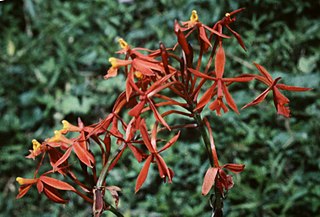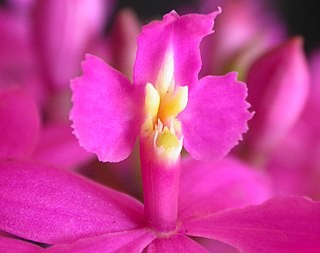
Epidendrum blepharistes is a species of orchid in the genus Epidendrum native to Bolivia, Colombia, Costa Rica, Ecuador, Peru, and Venezuela.

Epidendrum compressum is a species of orchid in the genus Epidendrum from wet montane forests of Trinidad, Venezuela, Colombia, Ecuador, Peru and Bolivia.

Epidendrum macrocarpum, widely known as Epidendrum schomburgkii, is a species of orchid in the genus Epidendrum, and the largest-flowering crucifix orchid species. Reichenbach thought that E. fulgens and E. schomburgkii var. confluens were both synonyms for this species.

Epidendrum ibaguense is a species of epiphytic orchid of the genus Epidendrum which occurs in Trinidad, French Guyana, Venezuela, Colombia and Northern Brazil.

Epidendrum rigidum is an epiphytic reed-stemmed Epidendrum orchid common throughout the Neotroical lowlands, below 600 m.
Epidendrum dendrobii is a terrestrial species of reed-stemmed Epidendrum of the Orchidaceae which grows on steep slopes in tropical montane cloud forests of Cochabamba, Bolivia and Venezuela at altitudes near 2.6 km.
The subgenus Pleuranthium of the genus Epidendrum of the Orchidaceae is distinguished from the other subgenera by having lateral inflorescences on the reed-like stems of the sympodial plant. With the exception of subgenus PsilanthemumKlotzsch, all of the remaining subgenera produce terminal inflorescences.
The subgenus Hormidium of the genus Epidendrum of family Orchidaceae features short pseudobulbs, a creeping growth habit, a very short peduncle, and a lip adnate to the column to its apex. The subgenus was published by Lindley in 1841.
The section Epidendrum sect. Planifolia of the subgenus E. subg. EpidendrumLindl. 1841 of the genus Epidendrum of the Orchidaceae was published in 1861 by Reichenbach It differs from the other three sections by having flat leaves. Like the other sections of E. subg. Epidendrum, the inflorescence grows from the apex of the stem, and bears no spathe or sheath at the base of the peduncle.

Epidendrum sect. SchistochilaRchb.f. (1861) is a section of the subgenus E. subg. AmphiglottiumLindl. (1841) of the Genus Epidendrum of the Orchidaceae. E. sect. Schistochila differs from the section E. sect. Holochila in that the species in E. sect. Holochila have undivided lips; the species in E. sect. Schistochila have lobate lips. The species in both E. sect. Schistochila and E. sect. Holochila have racemose inflorescences, unlike those in E. sect. Polycladia, which have truly paniculate inflorescences. Like the other sections of E. subg. Amphiglottium, the members of E. sect. Schistochila are sympodial orchids bearing thin stems with alternate leaves, a long peduncle covered with thin, imbricating sheathes, and a lip adnate to the very end of the column.

Epidendrum sect. PolycladiaRchb.f. 1861 is a section of the Subgenus E. subg. AmphiglottiumLindl. of the Genus Epidendrum of the Orchidaceae. This plants in this section differ from the plants in the other sections of E. subg. Amphiglottium by having truly paniculate inflorescences: the section E. sect. Holochila is characterized by racemose inflorescences and an undivided lip, and the section E. sect. Schistochila is characterized by racemose inflorescences and a lobed lip.
Epidendrum hemiscleria is a sympodial epiphytic orchid native to the tropical cloud forest of Ecuador and Peru, at altitudes near 3.3 km.
Epidendrum sect. Holochila Rchb.f. 1861 is a section of subgenus Epidendrum subg. Amphiglottium of the Orchidaceae. It differs from section E. sect. Polycladia by bearing inflorescences that are racemes, not panicles. It differs from section E. sect. Schistochila by having a lip with no lobes. Like the other sections of E. subg. Amphiglottium, plants of E. sect. Holochila exhibit slender stems covered with close imbricating sheaths which do not swell to form pseudobulbs, and terminal inflorescences covered at the base with close imbricating sheaths but without spathes.

Epidendrum sculptum is a sympodial, epiphytic reed-stemmed orchid native to the Neotropics from Chiapas Mexico to Brazil, at altitudes ranging from near sea level to 0.5 km.
The section Epidendrum sect. EquitantiaRchb.f. 1861 of the subgenus E. subg. EpidendrumLindl. 1841 of the genus Epidendrum of the Orchidaceae was published in 1861 by Reichenbach with the notation

Epidendrum subg. Amphiglottium(Salisb.) Lindl. 1841 is a subgenus of reed-stemmed Epidendrums, distinguished by an apical inflorescence with the peduncle covered from its base with close imbricating sheaths and by a lip that is adnate to the column to its apex.
Epidendrum parviflorum is a small-flowered reed-stemmed Epidendrum orchid found in the montane tropical wet forests of Bolivia, Ecuador, and Amazonas, Peru.
Epidendrum tridens is a terrestrial orchid closely allied to E. nocturnum, of which it has often been considered a variety or synonym. For example, Reichenbach 1861 lists Epidendrum tridens(Poepp. & Endl.) Cogn. (1898) as a synonym of Epidendrum nocturnum and Epidendrum nocturnum var. latifoliumLindl. (1837) as a distinguishable variety of Epidendrum nocturnum.
Epidendrum subgenus Aulizeum was raised from sectional status by Lindley in 1853. According to the Latin diagnosis, this taxon included those species of Epidendrum with a multi-lobate lip adnate to the column, with pseudobulbous stems, with the flowers sessile or born on racemes or panicles. In his further English description, Lindley stated that the species in this taxon have a horn-like stem which is only leafy at the end, and racemose inflorescences. In 1861, Reichenbach listed 32 species in this subgenus; of these, Kew recognizes 31 as separate species.

Epidendrum cylindrostachys is an epiphytic orchid native to the mountainous rainforest of Colombia and Peru, at altitudes near 2.5 km. According to the World Checklist, this binomial has no synonyms or homonyms.










